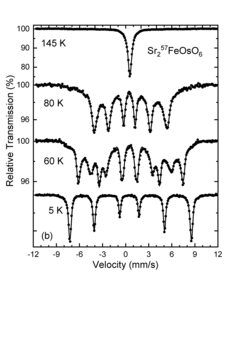Double Perovskites
Magnetization and neutron diffraction studies revealed that the double perovskite Sr2FeOsO6 features two magnetic phase transitions leading to magnetic phases AF1 and AF2, respectively. This is also evident from the Mössbauer spectra of Sr2FeOsO6 [1] (Fig.1, left). The isomer shifts are typical for Fe3+ for all the spectra which excludes that charge fluctuations are associated with the magnetic transitions. Above the Néel temperature the Mössbauer spectra show a slightly broadened single line, in agreement with the nearly undistorted FeO6 units in the crystal structure. Below TN = 140 K the appearance of a hyperfine sextet confirms the evolution of magnetic order. However, in the whole temperature range of the existence of the AF1 magnetic phase the lines are broad which suggests the persistence of a considerable degree of spin disorder or fluctuations. At 60 K a second sharper six-line pattern with increased hyperfine field Bhf indicates the transition to the more ordered AF2 structure which is nearly completed at 5 K.
We have studied the pressure dependence of the magnetism of Sr2FeOsO6 up to 50 GPa by synchrotron Mössbauer source (SMS) spectroscopy using diamond anvil cells and a sample which was partially enriched with the Mössbauer isotope 57Fe. An important result from this study is the drastic enhancement of the magnetic ordering temperature from 140 K at ambient pressure to above room temperature for pressures above 30 GPa, which is reflected in the presence of a magnetic hyperfine pattern in the high-pressure Mössbauer spectra (Fig.1, right). Such behavior is typical for electronically localized (Mott-insulating) systems. Broad spectra with coexistence of magnetic and non-magnetic signals reflect the complex magnetism in double perovskite systems where frequently competing exchange interactions occur.

Figure 2 (from Adler, 2019): High-pressure synchrotron Mössbauer source (SMS) spectra of Sr2FeOsO6 near room temperature which reveal the presence of magnetic hyperfine patterns in the high-pressure range. Experiments were performed on a sample which was partially enriched with 57Fe.

Figure 1 (from Adler, 2019): Ambient-pressure laboratory Mössbauer spectra of Sr2FeOsO6 at selected temperatures. At 60 K two hyperfine sextets indicate the transition from the high-temperature AF1phase with smaller hyperfine splitting to the low-temperature AF2 phase with larger hyperfine splitting. Experiments were performed on a sample which was partially enriched with 57Fe.

